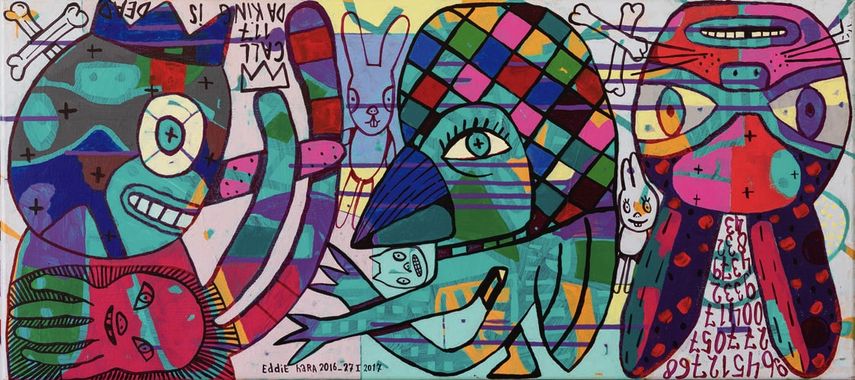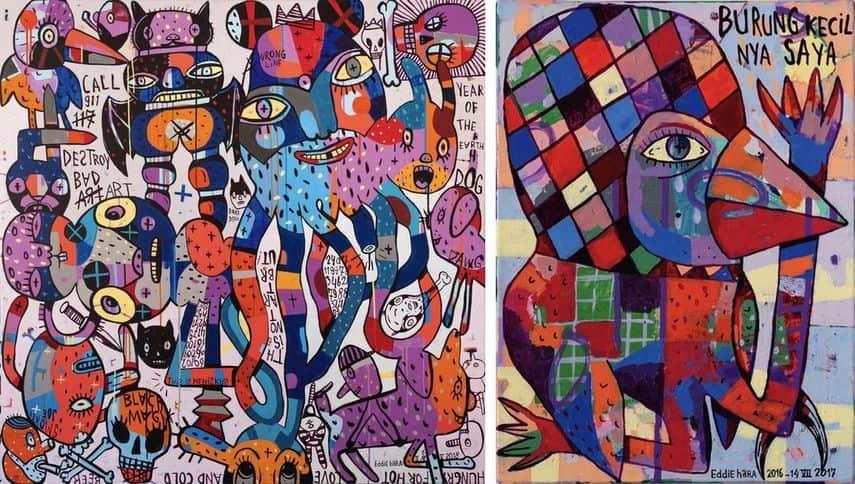[ad_1]
One of the most prolific Indonesian artists, EddiE haRA has developed a unique visual language informed by the wildness and innocence of raw art, eventually leading to the birth of a new genre.
Having a subculture mindset, he tackles a variety of themes, from environmental issues to the absurdity of contemporary life.
A selection of haRa’s works is currently on view in a solo exhibition at Artstübli in Basel. Titled This Is NOT Street Art!, the show takes the viewers on a journey through haRA’s colorful universe populated by outlandish creatures that sometimes can appear happy and fun, but can also bring out darker moods.

Blending a Range of Influences
EddiE haRA is often described as a retired punk in love with under sea creatures. His paintings blend children’s mischievous fantasies and the wildness of urban street life. His sources of inspiration are rich and varied, ranging from children’s drawings, underground, comics, robotic toys and bold colorful designs on skate gear, to modern graphics, primitive and folk art, rock and punk printed posters, TV news, sci-fi movies, graffiti, street art, and Mediterranean blue sky.
Refusing to work according to the dictating, narrow “cultural chauvinism” of Indonesian art, he absorbed stylistic influences of Dada, Fluxus and Art Brut, but also punk, heavy metal, and Street Art.
As he explained himself, his creatures are informed by both Javanese wayang characters and the Western cartoon icons, such as Mickey Mouse, Alice in Wonderland or Batman, which were a part of his imagination during his teenage age.

Ambiguous Creatures
There are several main characters that appear in EddiE haRA’s works: the jellyfish, the squid, the rabbit, the hat-wearing shoe/boot, and the human skull – often flying or somersaulting. Although these creatures seem merry at first glance, they embody both angels and demons, representing the ambiguity of human nature and social norms and values.
Painted in bright and cheerful colors, these hybrid creatures are often depicted as if laughing. However, their luminous eyes alter laugh into sinister a sneer, while their hands often grip a range of weapons. More recently, the artist has been incorporating a variety of icons that represent death and violence, such as skulls and fanged masks.
Texts in-between the drawings feature prominently in haRA’s works, ranging from amusing, random phrases to those expressing criticism or mere traces of verbal expressions lashing out in anger.
EddiE haRA – This is NOT Street Art! at Artstübli
EddiE haRA Exhibition at Artstubli
Moving one step beyond aesthetics, EddiE haRA aims to inspire the viewers to contemplate on important world issues such as politics, feminism, sexism, wars, poverty, racism etc.
The exhibition This Is Not Street Art! will be on view at Artstübli in Basel until June 30th, 2018. The Meet & Greet with the artist will be held on June 14th, from 4 to 7 p.m.
Featured images: Eddie Hara – Call 911. Destroy Bad Art (detail), 2018; Son of the Gun, 2015; Google me. Google me!, 2013 – 2017. All images courtesy the artist and Artstübli.
[ad_2]
Source link
